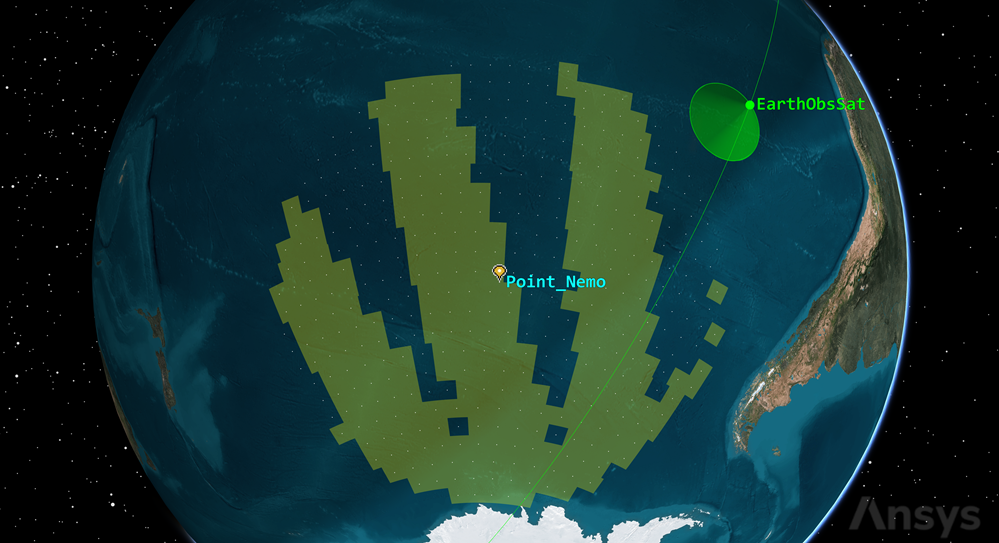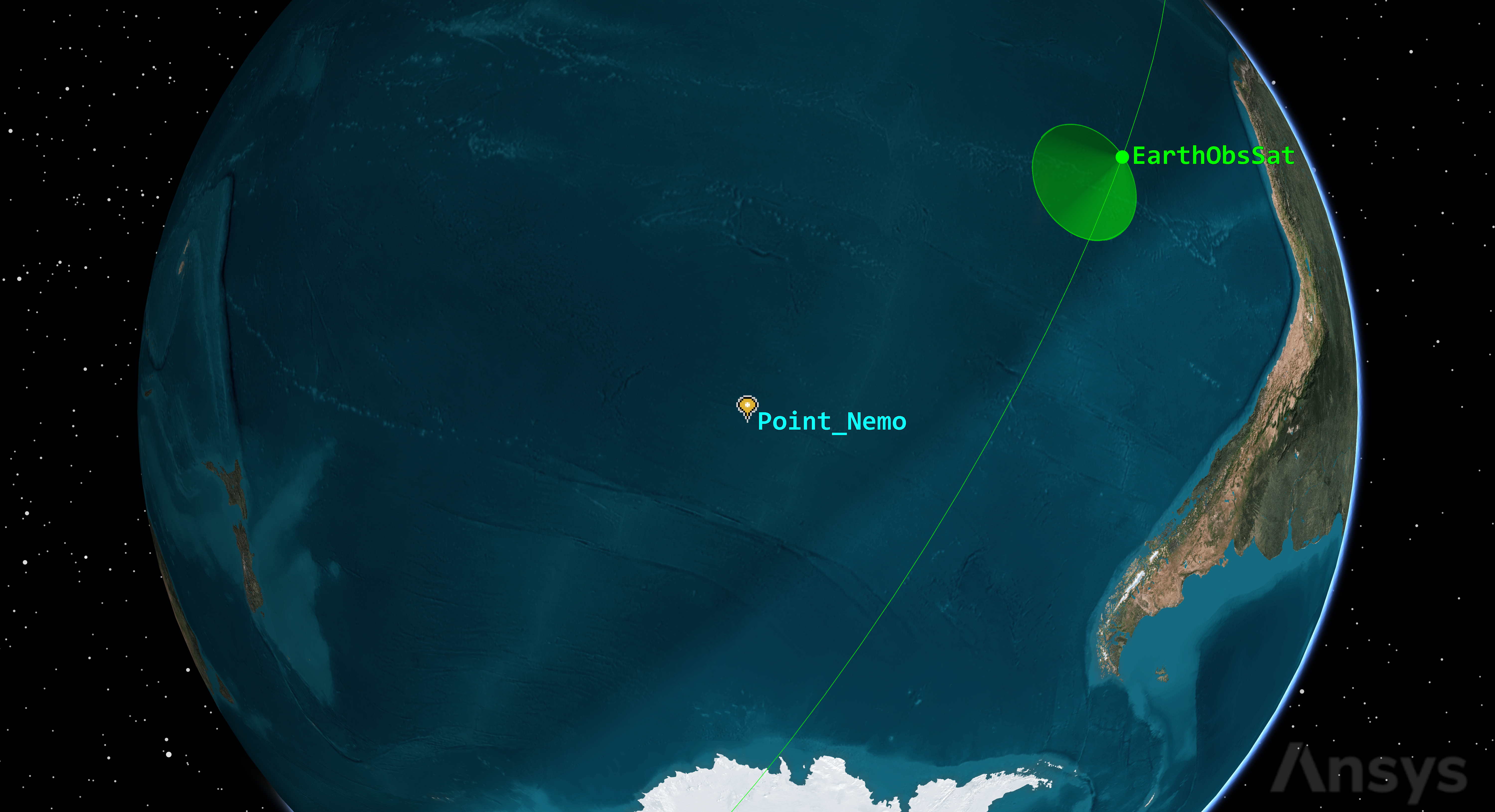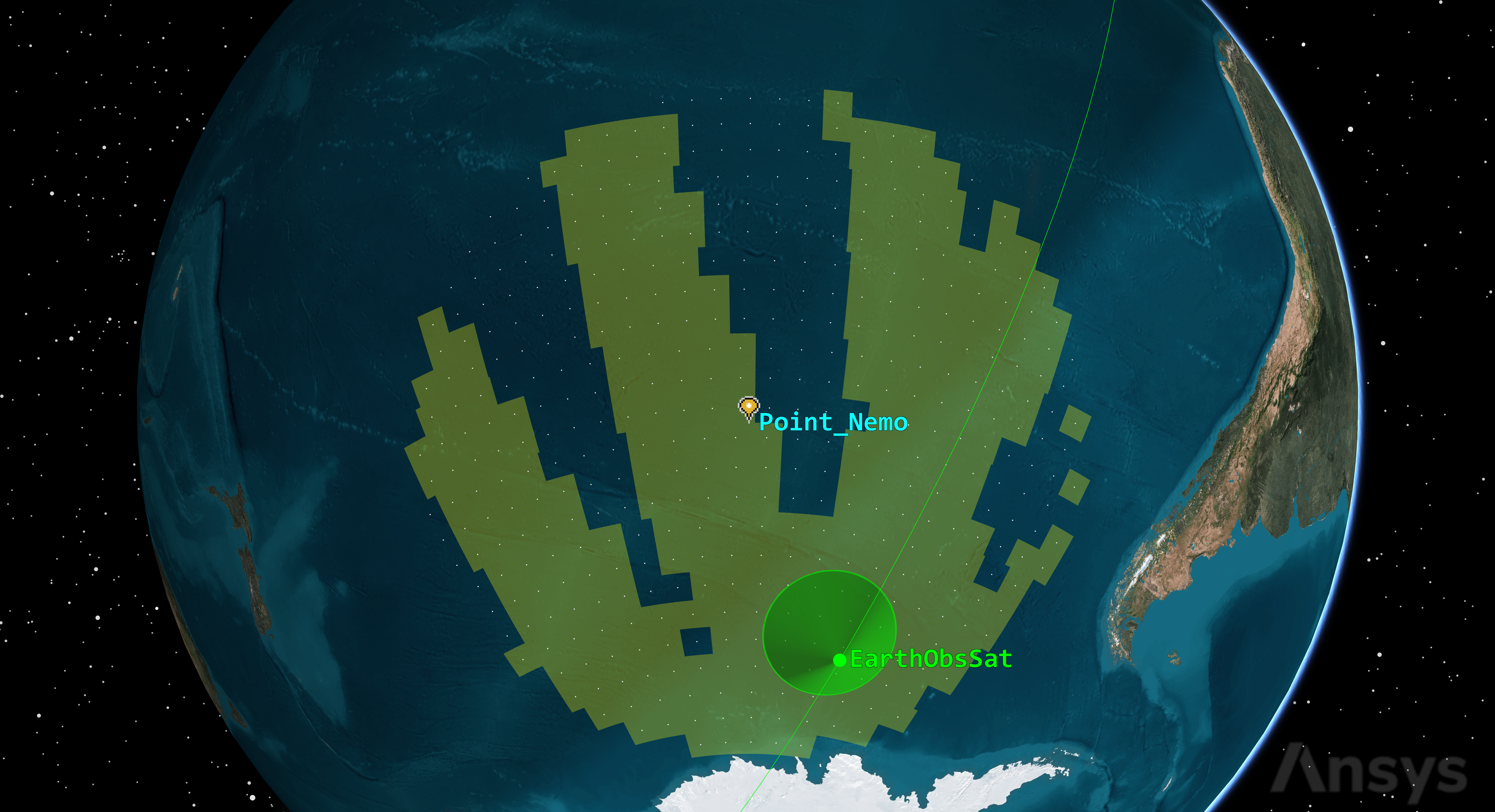Coverage Over the Satellite Graveyard
STK Free , STK Pro, STK Premium (Air), STK Premium (Space), or STK Enterprise
You can obtain the necessary licenses for this tutorial contacting AGI Support at support@agi.com or 1-800-924-7244.
The results of the tutorial may vary depending on the user settings and data enabled (online operations, terrain server, dynamic Earth data, etc.). It is acceptable to have different results.
This tutorial requires STK 12.9 or newer to complete.
Capabilities covered
This lesson covers the following STK Capabilities:
- STK Pro
- Coverage
Problem statement
You need to assess a future satellite’s coverage of the satellite graveyard. The satellite graveyard is a location in the Pacific ocean around a position known as Point Nemo. At 2688 km away from any coastline, this makes it a good location for disposing of inactive satellites. For the mission, your satellite will fly over the globe with an on-board sensor. You want to know how well it will cover the region. Additionally, the satellite will be collecting ground imagery, so ideally the surface of the Earth will be illuminated.
Solution
You will use STK to model the assets in the mission (the satellite, payload, and the ground marker). After modeling the assets, you will use STK's Coverage capability to measure the coverage of this region and analyze the results.
What you will learn
Upon completion of this tutorial, you will be able to:
- Model a Repeating Ground Trace Satellite.
- Model a sensor on the satellite.
- Create a place object for Point Nemo.
- Analyze the region with the Coverage Tool.
- Asses reports and graphs.

Figure 1: Mission Overview
Video guidance
Watch the following video. Then follow the steps below, which incorporate the systems and missions you work on (sample inputs provided).
Creating a new scenario
Create a new scenario with a run time of 1 day.
- Launch STK (
 ).
). - Click the (
 ) in the Welcome to STK dialog box.
) in the Welcome to STK dialog box. - Enter the following in the STK: New Scenario Wizard:
- Click to create the scenario.
- When the scenario loads, click Save (
 ). A folder with the same name as your scenario is created for you.
). A folder with the same name as your scenario is created for you. - Verify the scenario name and location in the Save As dialog box.
- Click .
| Option | Value |
|---|---|
| Name: | Coverage_Tool_Point_Nemo |
| Start: | Default |
| Stop: | + 1 day |
Save (![]() ) often!
) often!
Inserting a Satellite object
Insert a satellite object into the scenario. This satellite will have a repeating ground trace orbit. This will enable your satellite to orbit over the region of interest.
- Select Satellite (
 ) in the Insert STK Objects tool.
) in the Insert STK Objects tool. - Select the Orbit Wizard (
 ) method.
) method. - Click .
- Select the following in the Orbit Wizard window:
- Click .
| Option | Value |
|---|---|
| Type | Repeating Ground Trace |
| Satellite Name: | EarthObsSat |
Inserting a Sensor object
Insert a Sensor (![]() ) on EarthObsSat (
) on EarthObsSat (![]() ). Use the default sensor model, which will be a conical sensor with a 45 deg half angle.
). Use the default sensor model, which will be a conical sensor with a 45 deg half angle.
- Select Sensor (
 ) object in the Insert STK Objects tool.
) object in the Insert STK Objects tool. - Select the Insert Default (
 ) method.
) method. - Click .
- Select EarthObsSat (
 ) in the Select Object dialog box.
) in the Select Object dialog box. - Click .
Inserting a Place object
Insert a Place (![]() ) object into the scenario. The position of this object will be Point Nemo in the Pacific Ocean. This region is used as a satellite graveyard due to the fact that the closest coastline is ~2,688 km away.
) object into the scenario. The position of this object will be Point Nemo in the Pacific Ocean. This region is used as a satellite graveyard due to the fact that the closest coastline is ~2,688 km away.
- Select Place (
 ) in the Insert STK Objects tool.
) in the Insert STK Objects tool. - Select the Define Properties (
 ) method.
) method. - Click .
- Ensure the Basic - Position page is selected.
- Set the following:
- Click .
- Right-click on Place1 (
 ) in the Object Browser.
) in the Object Browser. - Select Rename in the shortcut menu.
- Rename Place1 (
 ) "Point_Nemo."
) "Point_Nemo."
| Option | Value |
|---|---|
| Latitude | -48.87 deg |
| Longitude | -123.39 deg |

Figure 2: Satellite with payload and place marker modeled in scenario.
Using the Coverage Tool
Now, that you have your assets modeled in the scenario, you will use the Coverage Tool wizard to analyze a region around Point Nemo. The Coverage Tool method is unique to inserting a Coverage Definition object into a scenario. Using the Coverage Tool method enables you to do the following:
-
Create a Coverage Definition object with your specifications of regions, assets, grid points, and graphic settings.
-
Create a Figure of Merit object with your specification of type and accompanying type specifications.
Inserting the Coverage Definition object
- Select Coverage Definition (
 ) in the Insert STK Objects tool.
) in the Insert STK Objects tool. - Select the Coverage Tool (
 ) method.
) method. - Click .
- Type "Satellite_Graveyard" in the Name: field when the Coverage Tool opens.
Configuring the coverage definition
- Select Point_Nemo (
 ) in the Custom Definition Area in the Regions panel.
) in the Custom Definition Area in the Regions panel. - Move (
 ) Point_Nemo (
) Point_Nemo ( ) from the Custome Definition Area list to the Regions list.
) from the Custome Definition Area list to the Regions list. - Set both the Semi-Major and Semi-Minor Axis to 2688 km.
- Set the Grid Point Granularity Lat/Lon to 2 deg.
- Expand (
 ) EarthObsSat (
) EarthObsSat ( ) in the Assets section.
) in the Assets section. - Double-click Sensor1 (
 ) activate it as your coverage asset.
) activate it as your coverage asset. - Confirm that Type: is Simple Coverage in the FOM Definition panel.
- Click .
Assets can only be selected by double-clicking on them. The term (Active) will appear next to an asset when it has been successfully selected.
Computing coverage
The ultimate goal of coverage is to analyze accesses to an area using assigned assets and applying necessary limitations upon those accesses. You will compute coverage with the Compute Accesses tool.
- Select Satellite_Graveyard (
 ) in the Object Browser.
) in the Object Browser. - Extend the CoverageDefinition menu.
- Select Compute Accesses. There is a progress bar in the lower right corner of STK.
Analyzing the results
You can use a Figure Of Merit (![]() ) object to choose a method to measure the quality of coverage.
) object to choose a method to measure the quality of coverage.
Generating a Percent Satisfied report
- Right-click FigureOfMerit1 (
 ) in the Object Browser when computing accesses is complete.
) in the Object Browser when computing accesses is complete. - Select Report & Graph Manager... (
 ) in the shortcut menu.
) in the shortcut menu. - Select Percent Satisfied (
 ) report in the Installed Styles list when the Report & Graph Manager opens.
) report in the Installed Styles list when the Report & Graph Manager opens. - Click .
- Note the % Satisfied value at the bottom of the report.
- Minimize the report when finished.
Generating the Grid Stats Over Time graph
- Select Grid Stats Over Time graph (
 ) in the Installed Styles list.
) in the Installed Styles list. - Click .
- Note the Max spikes. These are when Sensor1 (
 ) is directly overhead of the region.
) is directly overhead of the region. - Minimize the graph when finished.
- Close the Report & Graph Manager.
Viewing the Figure of Merit object
You examined your results analytically. You can enable the visualization in the Figure of Merit object.
- Right-click FigureOfMerit1 (
 ) in the Object Browser
) in the Object Browser - Select Properties (
 ).
). - Select the 2D Graphics page when the Properties Browser opens.
- Select Show Animation Graphics check box.
- Open the Show: shortcut menu in the Accumulation panel.
- Select Up to the current time.
- Click .
Visualizing the Figure of Merit object
- Bring the 3D Graphics window to the front.
- Right-click on Point_Nem (
 ) in the Object Browser.
) in the Object Browser. - Select Zoom To.
- Zoom out with the scroll wheel until you can see the satellite graveyard grid points.
- Click Start (
 ) in the Animation toolbar to animate your scenario. Sensor1 (
) in the Animation toolbar to animate your scenario. Sensor1 ( ) will add color to the region along its path when the sensor passes over the grid points.
) will add color to the region along its path when the sensor passes over the grid points. - Reset (
 ) the scenario when you are finished.
) the scenario when you are finished.

Figure 3: Visualized Coverage
Accounting for lighting conditions
You need day light to study the satellite graveyard with your satellite. You will enable a lighting constraint and apply it to your coverage definition so that the illumination is accounted for in the analysis.
- Open Point_Nemo's (
 ) properties (
) properties ( ).
). - Select the Constraints - Active page when the Properties Browser opens.
- Click Add new constraints (
 ) in the Active Constraints toolbar.
) in the Active Constraints toolbar. - Select Lighting in the Constraint Name list when the Select Constraints to Add dialog box opens.
- Click .
- Click to close the Select Constraints to Add dialog box.
- Open the Direct Sun shortcut menu in the Lighting panel in the Constraint Properties section.
- Select Penumbra or Direct Sun.
- Click .
Applying the lighting constraint
Set Point_Nemo (![]() ) as the grid constraint. It contains the constraint you want to apply to the coverage grid.
) as the grid constraint. It contains the constraint you want to apply to the coverage grid.
- Right-click on Satellite_Graveyard (
 ) in the Object Browser.
) in the Object Browser. - Select Properties (
 ).
). - Select the Basic - Grid page when the Properties Browser opens.
- Click in the Grid Definition panel.
- Set the Reference Constraint Class: shortcut menu in the Grid POint Access Options panel when the Grid Constraint Options dialog box opens.
- Select Place. For all object classes, the Basic properties of the object are applied to the grid points, excluding positional information.
- Select Use Object Instance check box.
- Select Point_Nemo in the objects list.
- Click to close the Grid Constraints Options dialog box.
- Click to accept the changes and close Properties Browser.
Determining coverage loss
Now that you have added in a constraint, you will reexamine the report and graphs.
- Maximize the Percent Satisfied report.
- Refresh (
 ) the report.
) the report. - Note the updated % Satisfied value at the bottom of the report (e.g. 78%).
- Minimize the report when finished.
- Maximize the Grid Stats Over Time graph.
- Refresh (
 ) the graph.
) the graph. - Note the changes in the access times.

Figure 4: Updated Percent Satisfied Report.
The results of the tutorial may vary depending on the user settings, scenario interval, and data enabled (online operations, terrain server, dynamic Earth data, etc.). It is acceptable to have different results.
Summary
In this lesson you placed a satellite in a repeat ground trace orbit, then modeled a sensor on it. Then, you created a place object and defined it's position with coordinates of Point Nemo. Once the assets were modeled, you used the Coverage tool to model a coverage around the point and a Simple Coverage Figure of Merit. After examining the results, you incorporated a lighting constraint and refreshed the reports and graphs to see the changes.
On your own
On your own, explore other ways to maximize your coverage. You examined a single day, what if the scenario was longer? What if the satellite had a different orbit? Explore other ways to modify your assets or your coverage to understand the mission.